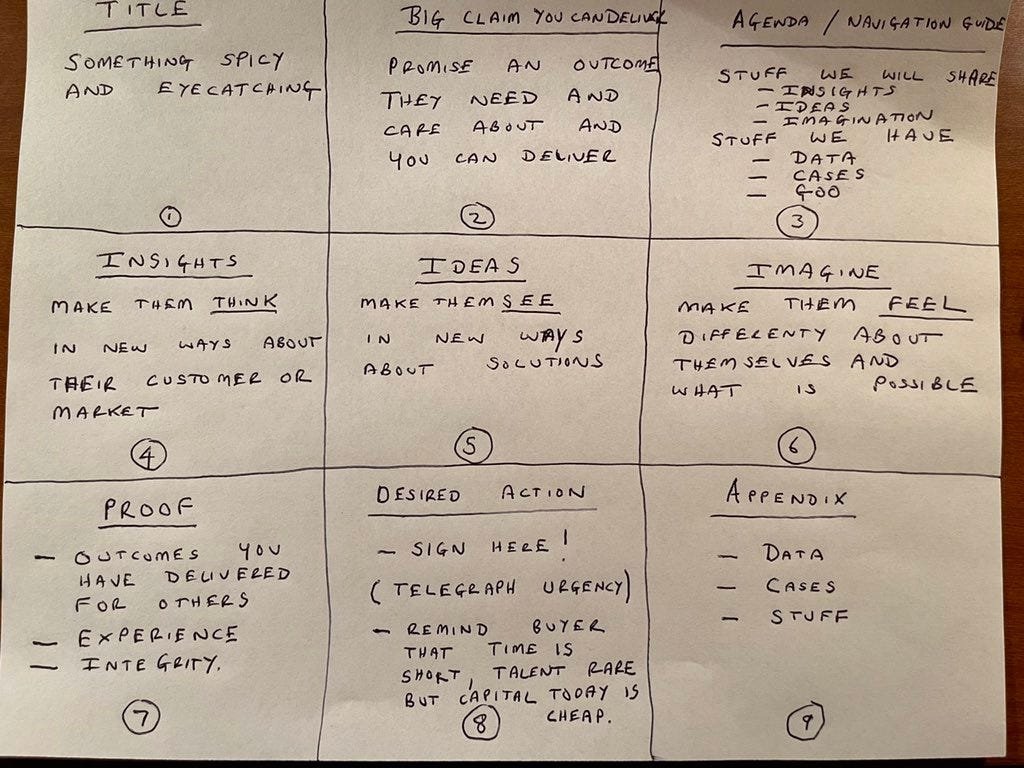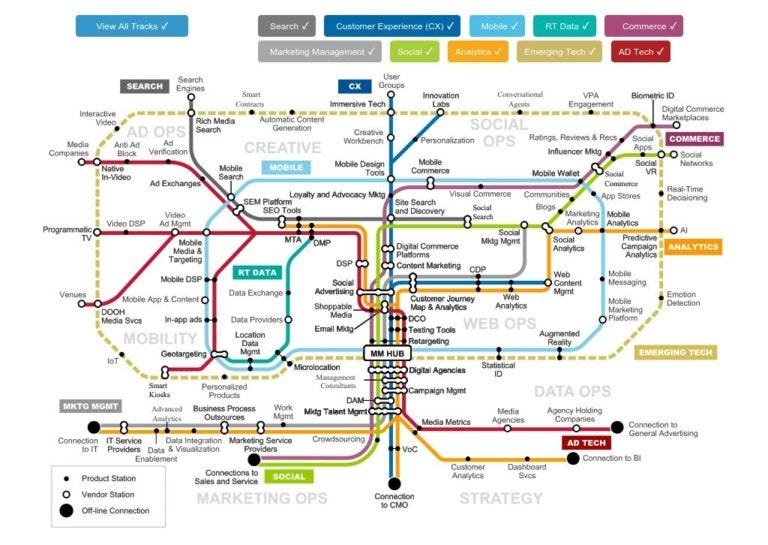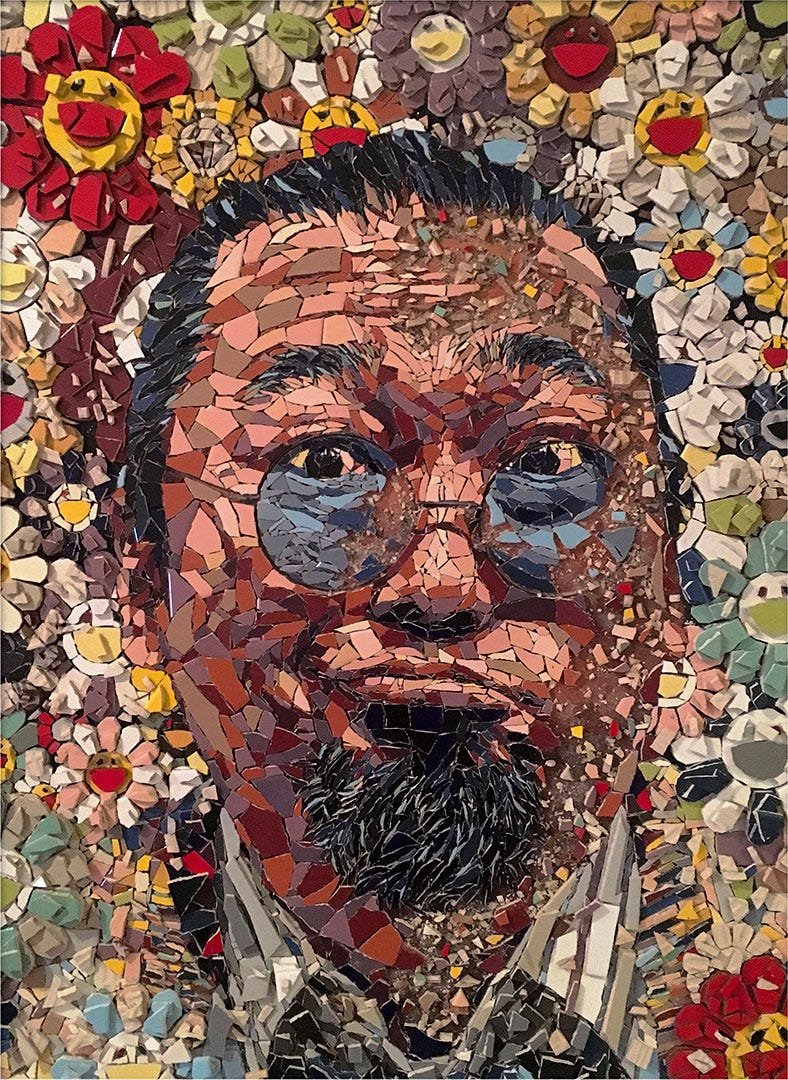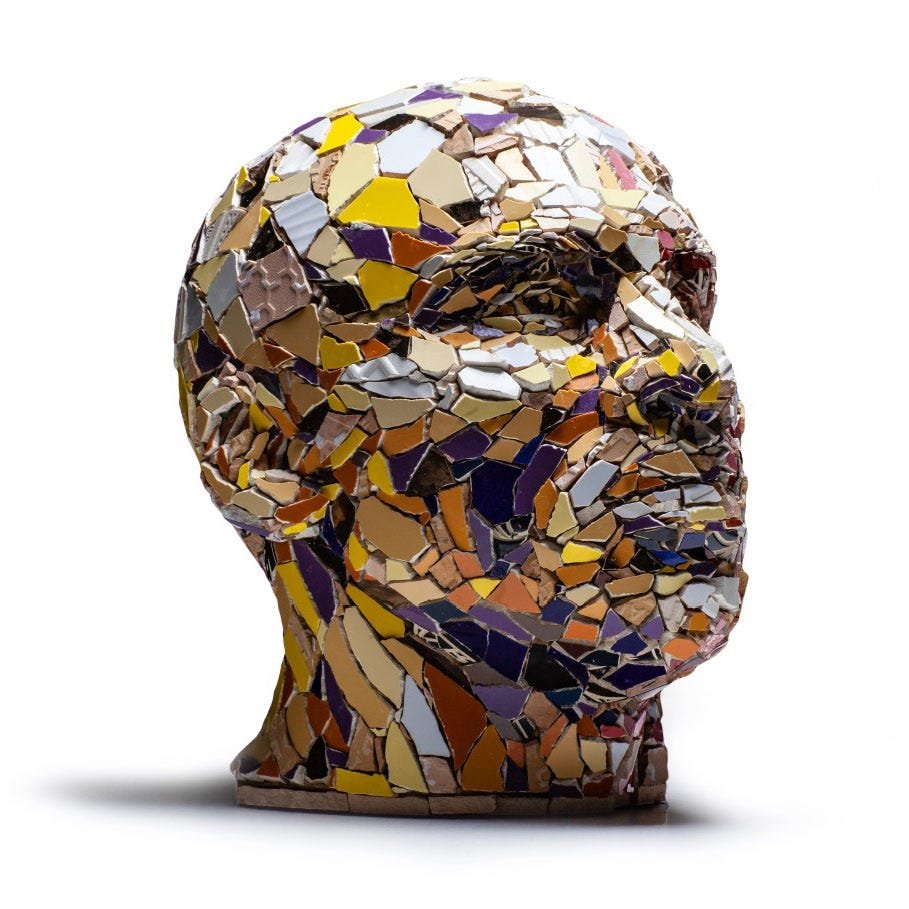We are all salespeople.
One does not need to be customer facing or have sales in our job requirement to understand the importance of being skilled at persuasion.
Whether it be to convince people about our point of view, get them to accept our recommendation or even attract a partner we all need to be able to sell.
Over years of observing people who not only are great at sales but do so in ways that feed, build and nourish strong ongoing relationships while also building goodwill, reveal four common practices:
Understanding needs: 8 Expectations.
Leveraging the concept of SAVE: Solution. Access. Values. Experience.
Unearthing answers the using a photography Metaphor: Frame. Illuminate. Edit.
High Impact presentation: Short. Punchy. Unforgettable.
Understanding Needs: Eight Expectations.
Four of these expectations are focused on outputs and outcomes and four of them focus on process or how the partner works.
Outputs: Insights, Ideas, Inspiration, and Implementation.
Process: Collaboration, Continuous Improvement, Operating Discipline, and Values.
Insights: Clients pay the highest premium in not just economic value but their attention and their admiration to firms that bring them insights about their customers or their business.
Inspiration: External suppliers and partners see a world different than a client. Most work across different industries and have a different employee mix. Clients in these changing times want to know how they benchmark against the best. Not just their industry, but across industries.
Ideas: In the end despite debate as to whether they pay adequately for ideas, every client cares a lot about ideas and without a good flow of them it is hard for an outside partner to remain valuable.
Implementation: Eventually insights, inspiration and ideas mean little if they cannot be implemented in the marketplace. Clients look for firms that have the skills either internally or thought tight partnerships to yield tangible programs, products or services into the marketplace in a cost-effective timely manner.
While insight, inspiration, ideas, and implementation are the wings of a healthy partnership, there are some processes or ways of working that are as important and often can carry a relationship when the ideas, insights, ideas, or implementation are wanting or can challenge a partnership when not present even if ideas, inspiration, and insights are flowing
Collaboration: Clients hate (and it is not too strong a word) the lack of collaboration between their various partners. They resent having to baby sit grownups who cannot play together. They see the friction as a loss of time and economic value.
Continuous Improvement: In a world of change, businesses ask if the outside partner is continuously improving themselves. Are they remaining curious, challenging the status quo, and leveraging technology or other efficiencies costs, becoming more productive?
Operating Discipline: This is the least sexy and interesting part of what clients want because in many ways they expect it. Can their partner run their own business by managing budgets, schedules, legal clearances, and the like? Are they responsiveness and do they staff with capable people?
Values: This is an expectation that has grown increasingly important over recent years as companies increasingly care about employee well-being, diversity, and purpose. Integrity and trust have always been critical to Clients, but they now want to know about the workforce of their suppliers and partners.
For a step by step guide on how to understand and meet client requirements click here
S.A.V.E.= Solutions. Accessible. Value. Experience.
Solutions
People and potential Clients look for solutions, but companies often focus on products, services, and processes.
This is understandable since the purpose of an organization is to provide products and services and often the way to differentiate oneself is by focusing on the special inputs (e.g., data), ingredients (e.g., saffron), processes (e.g., “bespoke”, “hand curdled”), approaches (e.g., some sort of diagram of how the company comes up with results) or organizational structure (e.g., “our special way of working and organizational structure that is silo-less, client focused and efficient”)
All of this is well and good and often necessary but never sufficient.
Because what the buyer is asking is “can you show me some cool shit instead of showing me how your colon works?”
Accessible
Today, most people are constrained for time and want things fast, friction-free and optimized for their personal situation.
Simplicity in understanding what is available.
Convenience in buying.
Flexibility in delivery and returns.
Optionality in payment terms.
Are our solutions easy to buy and ourselves easy to deal with?
For an organization this means being easily discoverable on all major platforms. Using language that is simple and free of buzz word bingo and jingo lingo. Being available to purchase or interact with across all channels and offering varied methods of delivery and payment.
People will not adapt to the way of the company, but the company needs to re-tool its spine to adapt to the way of the people.
Value(s)
Value is always a key since in addition to time, money is often a constraint for most.
This often requires competitive pricing but is not necessarily about selling out with the lowest price.
Ideally one finds a way to price the outcome versus the input.
Buying cheap pigs could lead to poisoned hot dogs.
Smart archers use fewer arrows and can get to the bullseye of solution faster, so quality has great ROI but often one must find ways to illustrate and numerate quality.
Some approaches include truly differentiated solutions or people where the result or experience are so clearly superior that premiums are justifiable.
It is important to note that Apple, LVMH, Disney and many others do not differentiate on price but value.
In addition, today like never before the values of a company or person matters.
Purpose.
A stance on ESG.
Approach to DEI.
Care and growth of employees and community.
All these now become ways to signal value and values.
Experience.
In the end people remember the experience and pay for the experience.
And much of business and marketing is creating seamless experiences or rectifying and correcting lapses in the experience.
Experiences have always been key but in the next few years as Web 3.0/The Third Connected Age scales with increasingly open, decentralized and composable systems, AR/VR interfaces, new organizational structures (DAO’s) and new currencies of trust and monetization (Blockchain driven tokens) it is likely to be the KEY differentiator
For a step by step guide on how to leverage S.A.V.E. click here
Unearthing Answers using a photography metaphor: Frame. Illuminate. Edit.
The essence of photography
At its essence photography is driven by three variables:
a) Framing: What the photographer decides to focus on, how the camera is angled and positioned relative to the subject and what is left in and left out of the viewfinder.
b) Exposure/Lighting: This is a combination of aperture, shutter speed and how sensitive to light the film is (ISO speed)
c) Editing: Once upon a time with analog film only professionals had the tools of editing (darkrooms, chemicals, and papers) but today with digital capabilities of our phones we all can pre-edit by taking several test shots, give ourselves lots of editing options by taking a lot of pictures and then later with easy-to-use tools sculpt our pictures to our liking by cropping and filtering and more.
The essence of problem solving
The best problem solvers tend to be good at three factors:
a) Framing the problem by asking the right question: They want to know whether one is solving the right problem.
b) Getting the right input/data/facts so they can throw as much light on the problem: Can one get as much illumination as one can?
c) Interrogating and iterating the answer: The first answers tend to be somewhat right and often lec to additional questions or additional fine tuning before one reaches a more robust solution.
For a step by step guide on how to use the photography metaphor click here
High Impact Presentations.
A case can be made that most presentation decks are
a) Un-necessary.
b) Too long.
c) A celebration of process versus product.
d) A mechanism of management control.
e) A waste of talent, time, and treasure.
f) A placebo pill for what can be cured with a conversation.
It may be time to re-think presentation decks.
Why most decks should be no longer than 9 slides.
Think of all the presentation you have sat through or produced. Many were fifty, sixty or hundred slides long. How many slides do you remember? How many stood out or made a difference?
Presentations are often un-necessarily long because:
a) We often confuse volume with quality.
b) Many people feel without a huge deck they cannot justify their expenses or point of view.
c) Often firms are paid by time exerted so they are incentivized to bloat and be baroque.
d) We often focus on how the colon works versus showing the cool shit by spending too much time about the process, the background, the history, the tools, the sources of data versus delivering the idea, insight, innovation, or imagination. If we need more than nine slides to tell our story, sell our point of view, or close a deal, we may not have anything truly convincing, differentiated, or interesting.
Over the years here is some learning gleaned from the best story tellers, salespeople, and communicators reduced to a simple exercise.
The best presentations are ones where you write the deck but never present or share it.
See above or below for a visual of how to limit any kind of presentation to 9 slides.
Begin with a letter size sheet of paper and a pen or pencil.
Place the sheet so it is in landscape mode.
Pretend you are playing tic tac toe and draw two vertical and two horizontal lines.
You now are looking at a slide view of nine slides on a single piece of paper.
Slide 9 is the appendix slide where you will list supporting material and will be the last slide you fill in.
Slide 8 is the Desired Action slide which highlights what you want to get from the meeting/ have the person you are presenting to act on.
This is the first slide that you fill in since this is what the point of the meeting you are having is.
Then the focus of your work is slide 4, 5 and 6 which you may want to label Insights, Ideas, Imagination. What insights about customer, consumer, marketplace, competition will you be sharing that get your audience to THINK differently? What one two or three big ideas are you delivering that will make their customers or consumers SEE them differently? What provocations, perspectives, points of view are you communicating that will get your audience to FEEL differently about their business, their future or you?
The goal of slide 4, 5 and 6 is to make sure you get the action you are looking for on slide 8.
Slide 7 is the Proof on why you or your firm should be believed, and this is where you show or share the cool results you have driven for other people.
Now you are ready to write the opening slides 1, 2 and 3 which are very key. Slide 1 should be a title that will make your audience come to attention, slide 2 a promise or some other benefit or outcome you will drive (e.g. your firm will generate 20 percent improvement or x or y) and then slide 3 which is the agenda slide or navigation slide which notes that you will be sharing ideas, insights, imagination and supporting material….but are ready to jump into any section based on what your audience is interested in first or how you have read the room at the beginning.
Finally slide 9 which is the appendix of all the supporting material that the first 8 slides are built on and can include data, cases, and other stuff.
Once you write this out you will find that you can make the entire presentation often without the presentation and at minimum you no longer have a long ponderous deck.
Instead, we have perspectives, provocations, points of view, insights, ideas, imagination, promises of delivery and a warehouse of stuff they can rummage through assuming they are interested.
Try this approach.
For more on the 9 slide presentation click here
The Future is Elastic!
“The Future is ‘Plastics’” was uttered 55 years ago in1967’s groundbreaking movie “The Graduate”. The “plastics” industry then boomed for decades but “Plastic” also meant fake, or artificial, unnatural. The statement “The future is plastics” was also code for all things that needed to be changed.
Elastic.
Today the one word would be “elastic”.
What is a simple definition of elastic?
Elastic, resilient, springy, flexible, supple means able to endure strain without being permanently injured. Elastic implies the property of resisting deformation by stretching.
The future is elastic.
People are increasingly living elastically in the way they shop, consume media, live, and work. They are stretching definitions and flexing and twisting.
The organizations that will thrive in the future will align with peoples’ new expectations and behaviors by being elastic in their structure and approach.
Those individuals most elastic in mindset who are ready to continuously iterate and adapt are more likely to thrive in transforming and changing times.
Source: Gartner
Source: Gartner
How people shop and consume media today are increasingly elastic.
The Customer “Journey” or “Funnel” is no longer recognizable.
Once upon an imaginary time there was a purchase funnel with awareness, consideration, intent and purchase as its four key movements and one could map a consumer journey.
In a world of fragmentation, empowered customers with super computers in their pockets and mongrel media like Tik-Tok which collapse above the line with below the line, fuse offline and online commerce and destroy any line between search, e-commerce, video, social and mobile, businesses are dealing with millions of journeys beginning, ending and lurching all over.
The neat little boxes and orchestrated behavior have dissolved into a cacophony of improvised jazz as the Gartner chart above illustrates.
Elastic companies will need to be not just omni-channel across all analog and digital platforms but also across multi-verses as the future of AR and VR begin to scale.
Source: World Economic Forum and Upwork.
Source: World Economic Forum and Upwork.
How people will work increasingly elastically.
Within five years projections suggest that most workers will have multiple employers.
Today we are living in a world of distributed and unbundled work (a process that began before Covid-19 and was just accelerated) across office, home, third places and event. A world where software, hardware and the Cloud allows many individuals to have access to the same technologies and platforms as large firms the nature of work is in flux. The future of employee will be a flexible combination of the full-time employee, the contract employee, the fractionalized employee and the free-lance employee.
In addition, in most countries with declining populations (pretty much everywhere outside of Africa and for a little while India) businesses will combine advanced technology and cast a wide net for employees who are increasingly diverse, older and distributed around a multitude of locations working for a varying number of hours. The work forces will span generations, cultures, working styles and mindsets like never before.
A multi-verse of talent is what companies will need to be prepared for.
Their big tent will need to be elastically stretchy offering a wide menu of ways to work.
Source: Carol Dweck
Success will require the need to stretch one’s mind and skill sets.
The rate of change today is speeding up and unless one is constantly learning, adapting, and questioning the status-quo we could find ourselves like the frog in the boiling water who did not pay attention to the rising temperature till it was too late to jump out before being cooked!
Every modern successful organization and leader is a target for dis-intermediation if we do not stretch ourselves.
Satya Nadella re-invigorated Microsoft after a decade of slumber increasing its market capitalization fivefold in five years by stretching out to incorporate open source (GitHub), social media (LinkedIn), gaming ( Minecraft and now Activision Blizzard), expanding into Cloud ( Azure) while torching stack ranking (which pitted employees against each other which made no sense when connection and collaboration are key), dropped the Windows Operating Division (legacy roots that were poisoning the ability to see in new ways) and most importantly made sure that everyone in his leadership team read and learned about Growth Mindset from Carol Dweck.
If we do not upgrade our mental and organizational operating systems to adapt to a high velocity and increasingly connected world we will fail to thrive.
Becoming Elastic.
Every individual, team and firm can become elastic.
Here are five ways to stretch:
Align with the future. Stop benchmarking against existing competitors and fixating just on current marketing platforms. Two years ago, many were convinced we were living in Google and Facebook world. While Google and Meta remain critical and are likely to do so for many years, we now have Tik-Tok, Amazon, and Apple that have scaled as significant marketing platforms joined by a plethora of commerce platforms like Walmart and Roundel from Target. In addition, many companies are creating their own connection platforms whether it be Marriott or McDonalds. It is no longer a two-horse race. As we enter the Third Connected Age of the Internet today’s eco-system will look simple.
Re-Think every aspect of the organization with a tomorrow lens.Like never before does the future not fit in the containers of the past. The future work force will be distributed, diverse, unbundled, empowered and older. They will be highly informed with many ways of monetizing their skills and often working for multiple companies. It’s no longer a question of if or when but how fast. Companies focusing on returning to the office (versus maximizing the benefits of in person interaction while ensuring flexibility) have not truly grasped the seismic changes in the future of work where this is just one of many challenges.
Accelerate speed of decision making and collaboration. Stretch one’s eco-system by incentivizing teamwork, being open to external partnerships and expertise and investing in upgrading skill sets and learning.
Recognize that in a world of machine learning and fragmented behavior, data will be exponentially more important. But not data itself but the ability to use data to illuminate opportunities, partnerships, and ROI by understanding patterns, combining math and meaning to drive data driven story telling and create an underlying infrastructure of intelligence and form that keeps the business focused and informed in a chaotic media, consumer, and competitive environment.
Combine roots and wings. Elastic means to stretch but not to be deformed. It is critical that as companies and individuals create new wings to soar into the future, they do not forget the roots that made them and will continue to make them who they are. Whether this be purpose, values, brand reputation or culture it is key to combine what’s next with what has been core.
Become elastic as the future becomes elastic.
A New ESG?
ESG has been important to companies and to investors though recently there has been some blowback from certain segments of the market on whether ESG is a feel-good, hard to measure, share-holder unfriendly and fuzzy goal.
This piece proposes that while ESG remains important a new ESG which is far more focused and therefore measurable, far more aligned with stakeholder value and more resonant with recent challenges needs to be acknowledged.
A new ESG.
What is traditional ESG?
A comprehensive definition from ADEC
Environmental risks created by business activities have actual or potential negative impact on air, land, water, ecosystems, and human health. Company environmental activities considered ESG factors include managing resources and preventing pollution, reducing emissions and climate impact, and executing environmental reporting or disclosure. Environmental positive outcomes include avoiding or minimizing environmental liabilities, lowering costs, and increasing profitability through energy and other efficiencies, and reducing regulatory, litigation and reputational risk.
Social risks refer to the impact that companies can have on society. They are addressed by company social activities such as promoting health and safety, encouraging labor-management relations, protecting human rights and focusing on product integrity. Social positive outcomes include increasing productivity and morale, reducing turnover and absenteeism and improving brand loyalty.
Governance risks concern the way companies are run. It addresses areas such as corporate brand independence and diversity, corporate risk management and excessive executive compensation, through company governance activities such as increasing diversity and accountability of the board, protecting shareholders and their rights, and reporting and disclosing information. Governance positive outcomes include aligning interests of share owners and management and avoiding unpleasant financial surprises.
A New ESG
ESG is and will continue to be important but it covers so many areas that it often feels unfocused and is often a something that has a section in an Annual report, a check box that must be marked and though essential to a healthy business is seen as a “nice to do” or a “we have to do” versus it’s the competitive advantage that will drive increased customer loyalty, enhanced attraction and retention of talent and increased financial value to owners and shareholders.
Today amidst the triple crisis of health, economic and social unrest reflected in Covid-19, generational shifts and Black Lives Matter a more clarified and focused ESG should be Employees, Society and Government.
Every smart company understands that purpose, values, doing good needs a focus on ensuring that their employees are well taken off, the impact of their products and services is a net positive to society and that they work in harmony with Government which is an essential force holding society together and providing resources to its employees.
Employees: Is the company ensuring security for their employees by paying a wage that allows them to have disposable income after they cover living, health and student debt? Are you providing adequate health care and an environment that does not put their physical or mental health at risk? Does the firm have diversity across the company and do people feel safe in speaking up? Are they investing in training? Most importantly are employees a cost or also an asset? Learn more about what PayPal has done in this area.
The most critical asset a company really has is its workforce. Four decades of experience and years of research for my book Restoring the Soul of Business: Staying Human in the Age of Data indicate that its employees who create the brands, the ideas, the experience that make a company and the only way a company improves and transforms itself is by growing the skills and unleashing the talents of its people.
Today employees are more stressed than ever and over the next few years companies will be made or broken based on what they do and did in the early 2020’s. The Great Resignation and “Quiet Quitting” are symptoms where the real questions are why, how, where and who we work for?
Society: We have always lived in a connected world but over the past few years we are more connected than ever due to search that allows us to connect to information, e-commerce that enables us to connect to anywhere to transact, social networks that connect us to each other and mobile phones that connect us all the time. No wonder that the key connecting companies of Google, Amazon, Meta and Apple are four of the most valuable companies in the world.
While many of these were funded by advertising and ran AOS (Advertising Operating Systems) or iOS (Apple) the reality is they are now Society Operating Systems and must manage themselves and be governed as such. But increasingly due to their scale, scope, and balance sheets more and more companies from Walmart to CVS to Starwood’s decisions change society. What are the implications on Society of a firm’s business decisions? Often the secondary effects of optimizing for business creates huge problems for society.
How can a company understand both what the ill effects might be to society but as importantly what good can one do for society as Walmart unleashed its logistics often after a hurricane. Society is often the community that companies are based in, or their employees live and where their customers make their life. Every company has the potential to be a net good to society while also ensuring profitability and growth, but it needs to be baked into its strategy.
A focus on purposeful good for society and multiple stake holders attracts not just customers but talent who feel more connected and prouder of such firms
Government: If there is one thing that Covid-19 and its aftereffects has shown is that government matters. The quality of governance matters. Even the University of Chicago professors worry that government has been captured by business and wonders how to save Capitalism from the Capitalists. Government has been underfunded, demonized, and lobotomized via lobbying and a platoon of politicians who believe they are in the business of entertaining versus running things and solving problems. More government may not be the answer, but better government and a more respected government is usually key for a country’s health.
Businesses must recognize that earning billions and paying peanuts in taxes eventually means no infrastructure, no public schools and much more. Running to government when things get tough but starving them when things go well is not aligned with purpose values and other high thoughts that gallivant and roam free on corporate websites.
So, every corporate leader, HR honcho, purpose driven person in a firm should ask?
Are we looking after our employees?
Are we thinking about society?Particularly the negative impacts of our products and services?
Are we helping government including paying taxes?
The Employee, Society, Government focus will need to be done first to truly realize Environment, Social and Governance goals.
Today more and more customers care a lot about how companies are looking after their employees and caring for society. If one is a senior manager, it is important to spend some time with employees in their 20s and 30s and learn how they truly care about purpose, values, fairness and this impacts their decision to stay or leave your company and much more.
From Patagonia to PayPal companies that do the right thing have the right results.
By focusing on the story of people, society, and culture they deliver the results they need for the spreadsheets.
Identifying, Growing & Recruiting Talent.
Mosaic by Jason Dussault
Today like never before we are living in a world of rapid transformation and change.
New industries rise and fall and the inter-connected unstoppable forces of globalization, demographic change and technology twist and toss all of us.
In this landscape how do we identify the key skills that we will need from talent or hone our own skills?
What will remain relevant and in demand in an age of shorter and shorter half-lives of firms and business models?
And when we recruit talent particularly talent from outside how should we maximize the likelihood of fit and success?
Mosaic by Jason Dussault
The Six C’s
Six key skills will be essential in the future.
Three of these have to do with individual competence (Cognition, Creativity, Curiosity) and three how we connect with each other and the world outside our minds (Collaborate, Communicate, Convince).
Very few people will be world class in all six areas, but we all need to grow to be very good in at least two in each area.
Many companies hire or tolerate unbalanced people who are ultra-strong in individual skills such as cognition and creativity but are terrible at collaborating or communicating and learn that these lop-sided folks almost never ever last.
Being great at collaborating and communicating but being lack luster in cognitive or creative and other skills also flames out as these folks do not earn credibility of insiders or clients. Similarly, brilliance without some basic people and communication skills always ends up poisoning cultures and eventually flaming out because the organization rejects these “smart porcupines”
Mosaic by Jason Dussault
The 3 C’s of Individual Competence
Cognition. Curiosity. Creativity.
Cognition is simply learning to think and keeping your mental operating system constantly upgraded. This requires deliberate practice and sustained work. Improved cognition is achievable.
But one must work at it and many of us are so swamped with keeping up with our daily workload that we do not invest in growing our skills and expertise. This proves to eventually lead to irrelevance as the needs for yesterday’s skill sets erode and one has not replaced them with a new set of skills for the future.
Creativity is connecting dots in new ways, looking beyond the obvious and this skill will be key as AI powered computers, data crunch and co-relate faster than we ever will.
To be human is to be creative.
Creativity is at its heart the way we deal with a world of change by adapting, evolving, and re-inventing.
We need to learn and feed this inside us. The future will be about data driven storytelling and not just data or storytelling and the ability to leverage modern machines and algorithms to unleash connection and meaning will depend on creativity.
Curiosity is simply being alive to possibilities, questioning the status quo and asking what if? Today the key competitor or opportunity in any category comes from outside it.
Curiosity may have killed the cat, but the lack of curiosity killed the careers of many people.
Mosaic by Jason Dussault
The 3C’s of Connecting
Being cognitively gifted, creative, and curious will not be enough since we are living in a connected world where eco-systems, teams and linkages is how ideas are born, value created, and long-term careers forged. For these we need to hone and build and train for three other skills.
Collaborate: Collaboration is key to work in a world where API’s (Application Protocol Interfaces) are not just about handshakes between software/hardware but between individuals with different skills, teams in different countries, partners, suppliers and much more.
Communicate: Learn to write. Learn to speak. Learn to present. It may be so old school but watch the people who succeed, and they are good at communication. And all of these can be taught and learned.
But communication is not a one-way street and as important as it to write, speak and present it is as critical to be able to listen, to hear and to understand what others are saying with an open mind and a sense of empathy.
Convince: Every one of us is a salesperson regardless of what we believe our title is. This is true even if we do not sell anything at work. We must convince colleagues of our points of view.
We all must learn to convince and learn to sell.
Mosaic by Jason Dussault
The 3 I’s of recruiting experienced talent from the outside.
It is rare that a company can avoid hiring significant talent from outside if it is serious about transforming itself to change and grow. New skills, new mindsets and new blood enhances the corporate genetic pool.
But these hires are particularly fraught, and experience indicates that we need to evaluate for the 6c’s but also look for three other critical factors especially when recruiting for senior roles
These are a) Integration, b) Integrity, c) Impact
Integration is about how will the person fit in the culture of the firm.
It requires multiple interviews (Zoom and wherever possible in person) and ideally as many colleagues of the person being recruited should have an opportunity to be exposed to their future colleague. While often this is difficult it truly makes the on boarding and acceptance of the outside individual much easier
Too many companies bring in a wunderkind who either fails to adapt or is chewed up and spit out by the organization. While “Culture” may eat strategy for breakfast it honed its chewing skills by gnawing on the bones of outside talent.
Integrity and the Impact needs to be evaluated over time and require in depth research.
Integrity has never been more important and in today’s correctly sensitized environment this is not just about financial trust but dealings with people of different backgrounds among other things.
Impact on Business can be measured through financial results but as important is how the individual has built teams, grown people, and dealt with long term periods of stress or setback. Be careful of people who switch jobs every 2 or 3 years since it is highly unlikely, they architected the success they may claim.
Ex-bosses and ex-direct reports rather than colleagues and industry experts are usually the ideal people to interrogate since they can provide perspective, put things into context and provide a multi-faceted picture of the person.
In the end every one of us is responsible for our own careers. We should not outsource our future to somebody else. We should evaluate ourselves and our teams on the 6C’s and invest time and learning utilizing both company and external resources to keep honing and up skilling ourselves.
The future will not adapt to us.
We must adapt, grow, and transform ourselves for the future.
Diverse Faces Are Not The Same As Diverse Voices.
All leaders face many challenges today, including organizational designs built for the past vs. the present, hierarchical command-and-control management styles that do not resonate with a new generation and employees who question their intent.
One key change that companies are making to address these issues is to ensure that they have a more diverse work force that will resonate with the marketplace and with their talent.
Ensuring diversity is not just the right thing to do, but is proven to be good for the bottom line as a representative workforce is a competitive advantage when talent is key, change is widespread and new ways of looking at things become critical.
Importance of diversity of voices.
However, ensuring a diversity of faces is a necessary but insufficient step. Not only do companies need different faces around the table, but they also need diversity in thinking. We need to ensure that every person in a firm and around the table has a voice.
Most importantly, it is critical to have voices that can speak truth to power, question the status quo, call out potential issues and be heard without the risk of being punished.
Today some of the issues that need to be discussed including a) how the most successful companies and leaders self-defeat themselves by becoming deaf, dumb and blind to the reality around them, b) how mangers instead of re-inventing how they work and finding ways to maximize the benefits of in person interaction are coercing people back to the office breeding long term disdain and resentment and c) how The Third Connected Age of the Internet driven by AI, 5G, Blockchain, AR/VR requires a top to bottom re-thinking of business models.
There are voices that question and have suggestions on how to solve or mitigate these issues.
If such voices were listened to, many companies, such as Wells Fargo and possibly Boeing, would not have suffered their reputational and market valuation losses. There were people who knew there were issues, but they either kept quiet or were silenced or ignored.
Speaking up. Speaking out.
For true diversity it is key that people can call out the turd on the table when everyone else is celebrating what looks like a delicious brownie.
This is very difficult since the issues being called out are challenging. Financial impropriety. Cutting corners to make deadlines, which hurts product or service quality. Loathsome behavior by management. Incompetence in adapting to change.
In addition to the difficulty of speaking out, there is the risk of job loss, increased workload to fix the problem, career blackballing and, of course, the possibility of being wrong.
But speaking one’s mind is not just important in helping to avoid big problems or issues. It also creates an environment that helps day-to-day business.
Increases effectiveness of teams: The best teams feel connected to each other and feel a sense of empathy and trust. Straight talk helps foster these qualities.
Gets to the root of problems: Continuous improvement is critical in a fast-moving competitive age. This means identifying threats, weaknesses, and issues. These are much easier to do when voices are not stifled.
Fosters creativity and innovation: For great ideas and creativity we need trampolines of trust and an environment where disruptors can disrupt without having their lives and careers disrupted.
How to unleash the voices within.
Speaking up is difficult in all circumstances but particularly if management and the culture is not supportive.
Studying many companies and organizations, including firms as diverse as Pixar and the Navy Seals, has revealed some best practices that one can unleash to encourage diversity of voice.
· Ask everyone to speak, from the most junior to the most senior.
· Celebrate truth-tellers and status quo breakers when they are right with promotions and financial rewards.
· Bring in outside voices to share cases from outside and run workshops.
· After each project ask how things could have been done better.
Management should ask people to build a case for why the decision being taken by management is wrong. A postmortem before the project has begun allows people to say what they need to.
Being sensitive to diversity of voices as much as to diversity of faces will ensure long-term success for companies.






























